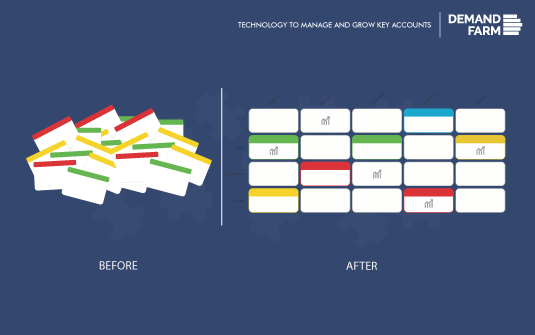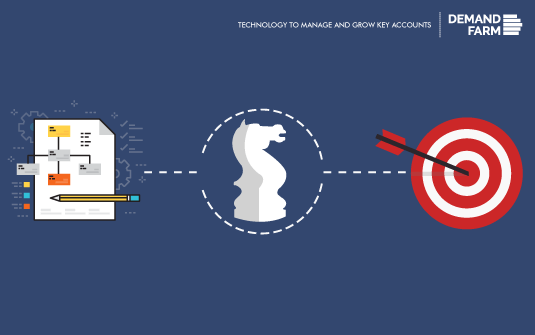Risk Assessment of Key Accounts during COVID-19 pandemic

Risk Assessment of Key Accounts during COVID-19 pandemic We’re in a global crisis that’s unlike anything we’ve seen or could have ever expected. All organizations are facing an unprecedented level of risk that requires timely action. “Predicting the unpredictable: dealing with risk and uncertainty” has always been a key mantra, and this holds today with the emergence of COVID-19. As an Account Manager, you are best placed to provide new insights to top management regarding the impact on your organization’s existing business and opportunity landscape. The impact on annual plans and account plan goals should be on your organization’s radar now to allow them to take consider these when making decisions. This is a time of rapid change. Drastic ad hoc actions are taken to address challenges to the business environment. Ad hoc strategic actions pose major risks and the evaluation of risk with each action is critical. The four keywords to keep in mind to manage risk during this crisis are mitigate, transfer, avoid, and accept. The first step to managing business risks is to identify what situations pose a risk to your finances. Consider the damage a risk could have on your business. Once you have a list of potential business risks, develop a process to weigh the severity it possesses for the key account. Set up a scoring system for risks, from acceptable to undesirable. Look at the likelihood of the identified risks occurring at your business. Gauge the financial impact the risk could potentially cause. Risk Assessment Framework 1. Risk Matrix A risk matrix helps you prioritize business risks by ranking the potential impact and likelihood for each account. Color coding helps visualize accounts based on their risk rankings, and you can also designate zones in your matrix as generally acceptable (GA), as low as reasonably possible (ALARP), and generally unacceptable (GU) to create an at-a-glance view of which key accounts to prioritize. 2. Risk Rating Key A rating key enables you to visualize risk rankings and designate the GA, ALARP, and GU zones. The rating key also suggests the preferred action for each of the 3 zones. 3. Risk Zones Generally Acceptable (GA): In the area of the chart ranked “low,” risks have little impact and/or are unlikely to occur. Risks in this region don’t pose an immediate threat to the project or organization, and some can even be ignored. As Low As Reasonably Possible (ALARP): This is a zone of acceptable risk, encompassing the “medium” ranking areas. Risks falling within this region of the matrix are tolerable or not significantly damaging; work can proceed without addressing these risks being immediate. Generally Unacceptable (GU): This is the area of the chart where risk is “high”. Risks in this region are quite damaging, highly likely to occur, and would threaten the project or organization. They are the highest priority, and you must address them immediately. 5. Financial Impact The total financial impact of the risks across your organization categorized by the zones and by the severity to re-evaluate the guidance numbers for the entire organization. 6. Risk Response Plan The account manager can plan for managing the risk(s) (Avoid / Transfer / Mitigate / Accept) for the key account management. Action items for the same can be planned. Support required from peers, partners, or third parties can be highlighted timely, acted upon, and followed up. Your business risk assessment is not a one-time commitment. Review risk management processes periodically to see how you handle risks. Also, lookout for new risks that might not have been relevant in the previous assessment of the key accounts. DemandFarm’s Account Planner enables you to do this risk assessment inside your CRM making the Account Manager’s job easy. This simple risk analysis will help you avoid hazards that could damage your finances. The risk assessment of key accounts informs you about the steps you need to take to protect your business. You can see what situations you need to address and avoid.
Account Planning Template – Step by Step Guide to Strategic Account Planning

Account Planning Template Existing customers are a critical revenue source for every organization. Meeting growth targets requires sales leaders to build robust strategic account plans and establish well-defined account management processes in the organization and this is where account planning templates come into the picture. Having a customizable template for account planning not only helps retain customers but also enables account teams to identify, develop, and execute growth opportunities within their account base. KAM Glossary: Crucial Account Management Terms Explained What is Account Planning? Account planning is a process of building strategic plans to improve value-driven relationships with key customers that can help in long-term development and retention, thereby maximizing the revenue potential. Effective account plans and templates help account managers gain a more in-depth understanding of the client. The Account Planning Book of Evidence study surveyed 1034 people from 62 countries to determine why organizations undertake the account planning exercise. Most of the results were unsurprising: Better Win rate (75%) Increased understanding of customers’ business (72%) Shorter sales cycles (58%) Better customer loyalty (55%) Increased deal size (49%) Better executive access (47%) Identify non-competitive deals (27%) The Account plan contains critical information about the prospect that every sales rep should know before even thinking about making the initial phone call. Capturing this information down in a concise, structured way helps the salesperson to focus on what is important about the account and how it aligns with your company’s offering. Having a plan can help you go one step further, give you the edge over a competitor, or deliver the crucial piece of data that can close the deal. Simply put, the Strategic Account Plan is the blueprint of the sale. Here, is a template to create quick and effective account plans that help account managers win the game. Account Planning Template 1. Account Overview Documenting the Client’s landscape is important to give a bird’s eye view of their business and general information to the account managers for them to dive deeper. Also, this information must answer all the basic questions about the client like What the client sells, who are their clients, what size are they, where are they located, and much more. 2. Account Segmentation Account Segmentation will help the sales team segment the client accounts into different buckets. This enables the salespeople to come up with the right strategic action planning based on the account positions. You can segment accounts based on the account health score to understand them objectively. 3. Account Financials Understanding the basic financials of the client organization will help identify your potential revenue sources. Also, listing the specific business units and geographic regions of the clients will enable you to know the areas to which you can cater and estimate the Total Annual Revenue potential from the client. 4. Whitespace analysis Whitespace mapping is the virtual representation of data to uncover hidden white space opportunities to target. It helps you to identify the gap between the products/services your customers require vs the products/services you offer. Understanding the pain points at different levels and offering the right solution helps increase revenue from the existing customers. The Sales team can understand current engagements with accounts and explore possible opportunities & whitespaces with the white space analysis. Learn More: Opportunity Planner by DemandFarm boosts tracking capabilities in 65+ opportunities for Dairy MAX 5. Relationship mapping Relationship mapping helps to visualize all the key stakeholders in one place. This mapping tool – org chart software also helps salespeople to explore detailed information about the contacts of the accounts on the budget control, influences they have on each other, etc., You can Know the organizational hierarchy of the accounts to better understand the relationships and the influences between the contacts. 6. Competitor Analysis Competitor Analysis allows you to better understand the market, potential, and behavior of the customers. This analysis with a bunch of data gives a company an advantage over the competitors to grow by developing new market strategies. With competitor analysis, the sales team can also understand the strengths and weaknesses of competitors along with the analysis of customer spend vs wallet share. 7. Communication Planning Capturing all the past interactions between the client and the team will help to sketch the communication pattern that can add value in planning the overall communication strategy. It gives you a year-wise verdict on whether you are in super touch or you need to work more on the volume of meetings. It’s an extremely important exercise to improve your communication strategy to maximize ROI. 8. Account Management KPIs Defining the Account management KPIs is critical to measure the progress of accounts over time, make adjustments in the process & stay on track, solve problems that are in the way, and tackle new opportunities in the accounts. It also helps in analyzing account planning patterns over time. Learn More: 11 Crucial Account Management KPIs that dictate Success Why do you need a Sales Account Planning template? Creating a Strategic Account Management template is not an easy exercise. It can’t be done in an hour before a meeting. So there is a need for a template that can help account managers build quick and effective plans. Most importantly, it gives you a better framework of the data needed to understand the customer. Knowing more about your target and being equipped with insider account knowledge of the account is one of the biggest advantages a salesperson can have. DemandFarm’s Account Management Software DemandFarm’s Key Account Management Software enables dynamic account planning capability natively inside Salesforce CRM and integrates to all other leading CRMS to make account planning ridiculously easy. It helps in achieving a deeper understanding of your Key accounts through improved data visualization and qualitative analysis. Our key account management software empowers companies to visualize, plan, and drive growth in Key Account Sales. Our digital account management experts will be more than happy to guide you. Book a demo today.
Sales Account Planning – A Step by Step Guide

Sales Account Planning What is a Sales account plan? A Sales account plan is sort of like a guide with all the critical information a sales team wants to close each of their crucial accounts and keep them for the long run. It is more often used to establish sales objectives for the team and develop strategies necessary to achieve them. Companies of all sizes may use variants of account programs based on the industry, type of client, and sales team structure. If you have ever been to a restaurant where the host includes all the detailed information concerning their valued guests about the interests, relationship, and buying habits that an add-on to the experience, then you’ve seen a sales account plan in action. Think of your account as guests along with sales account planning as a way that you show how much you understand and value your guests. Sales account plans may include a range of information, including company size, key decision-makers, timelines, and also a listing of the company’s competitors and the business’s market share relative to their competitors, as well as their strategic decision-making process. Steps to prepare a Sales account plan Successful sales account planning requires more than just filling out a form. It requires strategic thinking and a clear understanding of what your client needs. Outline the business objective The First step is to outline the objectives by understanding the organization’s current mission and vision, the industry trends, the market potential. Mapping these data with the sales acceleration goals and the product/service offerings of the company can help a sales team set up their objective. Define the target clients The next important step is to analyze the clients with the necessary tools to find the most profitable and lucrative prospects and customers defined by industry, region, product, etc. This analysis can help the sales team know the challenges and hunt for profound growth opportunities to grow the revenue. Build your strategies and tactics List your overall objectives for the accounts and plan how you will get to your goal. It must answer the questions like, “What are our objectives, and what’s our overall direction to achieve them?”. It must include the goal build that takes the overall growth objective into account and builds up the components of how the team’s going to reach that objective. Select the necessary tools for account analysis Understanding the accounts, analyzing, planning, and delivering the right solution for the right customer requires rigorous efforts at the backend. But this can be simplified by employing proper account planning tools with advanced features. Assign the KPIs Build a Performance Dashboard that sets milestones and tracks the progress to those milestones; it also helps identify any adjustments that need to be made. It must answer the questions, “How have we performed? How should we adjust?” Key components of the Account analysis It’s getting increasingly difficult and complex to understand the client business to answer this question: How much will the client be ready to spend on our product? Successful salespeople must dig deeper into the complexities to solve the puzzle. A list of analyses over the client’s business with the previous year’s data can help not only answer this but also can track new opportunities within the accounts. Learn More: Opportunity Planner by DemandFarm boosts tracking capabilities in 65+ opportunities for Dairy MAX Account Segmentation Account Segmentation will help the sales team segment the client accounts into different buckets. This enables the salespeople to come up with the right strategic action plan based on the account positions. You can segment accounts based on the account health score to understand them objectively. Relationship mapping Relationship mapping helps to visualize all the key stakeholders in one place. This mapping tool – org chart software also helps salespeople to explore detailed information about the contacts of the accounts on the budget control, influences they have on each other, etc., You can Know the organizational hierarchy of the accounts to better understand the relationships and the influences between the contacts. Competition Stacking Competitor Analysis allows you to better understand the market, potential, and behavior of the customers. This analysis with a bunch of data gives a company an advantage over the competitors to grow by developing new market strategies. With competitor analysis, the sales team can also understand the strength and weakness of competitors along with the analysis of customer spend vs wallet share White space analysis Whitespace mapping is the virtual representation of data to uncover hidden white space opportunities to target. It helps you to identify the gap between the products/services your customers require vs the products/services you offer. Understanding the pain points at different levels and offering the right solution helps increase revenue from the existing customers. The Sales team can understand current engagements with accounts and explore possible opportunities & whitespaces with the whitespace analysis Benefits of Sales account planning Better Win rate Increased understanding of customers’ business Shorter sales cycles Better customer loyalty Increased deal size Better executive access Identify non-competitive deals DemandFarm’s Account Planner DemandFarm’s Account planner offers integrated account planning inside CRMs that makes sales account planning ridiculously easy. It helps in achieving a deeper understanding of your Key accounts through improved data visualization and qualitative analysis. Salesforce is one of the most popular customer relationship management tools in the world and our products are Salesforce native which means Salesforce Account Planning becomes a breeze.
5 Essential Skills of Account Managers

5 Essential Skills of Account managers It takes months of conversations, demos, and meetings to close a deal. Both parties will be excited about the partnership. But now what? It’s critical to building a healthy strategic relationship with the client that can assist you with retention and expansion. A well-structured account management process in place might be your key. Guide: Comprehensive Career Path for a Key Account Manager What does an account manager do? An account manager is accountable for the overall management of sales and relationships with customers of the company. Account Managers are always on the lookout of developing and maintaining a strong relationship with the customer by addressing their concerns and needs. What is account management? Account management is a collective strategic method that businesses use to upkeep their best clientele all along with their entrepreneurial journey. It is a process of overseeing the sales structure, planning the business continuity, and managing client relationships coherently. According to a study done by Gartner, customer service doesn’t drive revenue, but customer improvement might do the trick. And that is where key account management responsibilities comes into play. KAM Glossary: Crucial Key Account Management Terms Explained Account Management vs Sales The perspective differences between these two propositions are far and wide. The very difference between account management and sales can be illustrated with the example of a nomad merchant and an online global store. A nomad merchant aims to sell out the commodities in any means to the customers around his way. And the merchant’s sales proposition keeps varying. The online store reaches a far wider customer audience. The online shop owner equips the shop and supports the customer with all possible facilities. Likewise, account management finds the scope for future benefits rather than the benefit of a one-time deal. Not surprisingly, the art of strategic account management and identifying key accounts is a complex process. You have to carry out a broad business prospect to afford and manage such accounts because they are going to get the benefit of your time and effort in the long term. Who are account managers? Account managers are generally a liaison between the business and its clients. They are essential to building strong strategic relationships and a healthy bottom-line with clients. Account managers think strategically and explore white spaces with the clients to retain the business and crack opportunities. White space refers to the gap between the products or services customers have currently invested in and the other products or services that your company can offer to them. The account manager has to take the responsibility to mitigate the challenges, solve the problems and find new opportunities to enhance client relationships. They play a prominent role in the business process to enhance business prospects with the best clients with long-term engagement. While all the account managers need hands-on experience managing customer relationships, there are wide ranges of other (equally important) account management skills that are critical for the role. 5 Account manager skills you will need to master 1. Good listening and understanding capacity In a business organization, good listening is the key to effective working relationships with clients. Listening helps to acquire facts that assist in better decision-making. It is also essential to building trust and can reduce conflict. Purposeful listening can help build objectives, find opportunities and enhance relationships at every interaction with the client. The next essential skill is to understand the bigger picture of the client’s needs and business specifics. Thoughtful analysis can help you anticipate the needs and exceed the expectations. This can be achieved through effective questioning. The account managers must formulate questions that engage the mind and direct the thinking. Effective questions lead to useful pieces of information for decision-making. 2. Collaborative and Customization ability Account management is never a solo game but a collaborative effort. In the evolving business world, companies can’t compete on pricing/product alone. Companies must differentiate themselves with their customer experience. Collaborative selling is the future. Collaborating with customers to make them fully participate in the process can help build strong relationships, in turn, drive sales forward. Even internal team collaboration is essential for a sales account manager not only to relieve his pressure but also to get fresh and different perspectives to solve the problem. 3. Leadership and Ownership capability Account leaders always work towards a vision and have the ability to inspire clients with a creative plan for the future. They challenge the clients and encourage them to make brave decisions. This can help build strategic account planning for disruptive transformations. Account Leaders are unique and embrace changes in every process that can yield huge results. They focus time and attention appropriately on the development of key accounts with a clear idea of actions. 4. Dynamic Business Analytical knowledge Analytical thinking is the key ability to quickly identify the cause and effect relationships. This means understanding the scenario of what might happen in the process and proactively offering a solution to that. Dealing with a pile of information from various sources is critical for every account manager in his day-to-day work. So, having good attention to detail is necessary to notice, retain, and carefully evaluation of client problems. 5. Excellent communication skills Being the liaison between the client and the company, a successful account manager must excel in communication skills. This is necessary to build a strategic relationship with clients and retain them. Keeping everyone in the team well informed about what’s happening and also the results of every process helps in coordination and maintaining rapport. Whether oral or written, the account manager must be able to be clear, concise, and convincing with his thoughts. Key Account Management is a continuous process that requires immense effort from highly skilled account managers. But that’s not enough, the account managers must be equipped with the right key account management tools and account planning tools that can assist them throughout their journey and make life easier. Demandfarm’s Account Planner makes account planning ridiculously
White Space Opportunity : Your potential areas for growth

White Space Opportunity The ultimate goal of key account management is to recognize opportunities for growth in their strategic accounts. At DemandFarm we have designed a simple yet powerful framework to identify potential business growth through white space opportunity. What is a White Space? Are you giving all your focus to new opportunities or keeping an eye on current customers to see if there are any emerging opportunities? There is a gap between when your sales professional finalizes a deal with a new customer and start fresh with a new prospect. To fill out this gap, did you know that it costs 10 times less to sell to an existing customer than to acquire a new one. The gap between the products or services that your existing customer has purchased and the other products or services that your company has to offer is known as white space. The goal of this identification is to seek growth of key accounts which is done through existing solutions and relationships. Failure to realize these opportunities, leaves a lot of money on the table and also allows competition to sneak in. These white space opportunities can be unearthed through creation of a visual white space map and it’s careful analysis. Here is how it works. Step 1: Identification of Offering Identify and list down all the products/services/solutions that your company sells to the customer. Let’s call them OFFERINGS. It is advisable to not exceed more than 10 offerings. If your company has more, try to have sub offering classification and club more than one sub offerings to a single parent offering. Step 2: Identification of Buying Centers Identify and list down ‘Buying Centers’ in the account. Buying Centers are those units in the account that can buy your offering(s) independently. They could be various divisions of the account or functions in an account or territories in the account. They can also be a combination of these three. This is tricky. It requires a deep understanding of the account in terms of organizational structure, power centers, decision-making process, budget allocation, etc. Therefore, this step is not static. Buying Centers could change or get added over a while. If you don’t know the account well, it’s ok to start with just one. Since it is tricky, let me explain with an example. Let’s say your key account is a large global bank. Divisions may include the following: Retail Banking, Wholesale Banking, Investment Banking, Merchant Banking, Asset Management, Wealth Management. Functions may include: Finance, IT, Sales, Marketing, Operations, HR Territories may include: North America, Europe, Asia, Africa, Latin America. Now depending on what your offerings are, Buying Centers could be: Retail Marketing, Asia Operations, IT infrastructure, Asia, Wealth North America. You get the drift. One thumb rule is Buying Center should be able to independently buy at least one of your offerings on its own. Step 3: Creation of Account Landscape Create a matrix/grid using these two lists – Offerings versus Buying Centers. I call it Account Landscape. Here is an illustration. Step 4: Insertion of Opportunities Data in the Account Landscape Mark all the areas where you already do business in the Account Landscape with opportunities data. This could be all ‘Closed-Won’ opportunities in the past 12 to 24 months. A view of ‘Closed-Lost’ Opportunities is also helpful to know where you did not win. Also, of course, active opportunities in pursuit now. Step 5: Analysis of the relevance of Offerings Examining each offering and deciding its relevance in this account is the next step in white space analysis. Not every offering of yours is relevant to all accounts. It is very helpful if you can also assess the intensity of competition where relevance is high. Similarly, assess each buying center for its attractiveness. A simple RAG (Red-Green-Amber) analysis will do. Look at the illustration below Step 6: Identification of White Space Opportunities Now, it will be easy to identify this white space opportunity for business growth. Start with ‘Green’ boxes and see vertically and horizontally where growth can happen. There could be opportunities to ‘mine’ for more revenue in existing projects. In the illustration above, I have identified 3 of them. Highly relevant offering with highly attractive buying centers gives me two of these opportunities. It also helps that we are already engaged with other offerings in these buying centers. As you can see, a methodical approach to unearthing new opportunities to grow your accounts as illustrated above is very impactful. At DemandFarm, we have made this process easy by building these tools inside your CRMs. We believe that the Account Managers are the heroes. Their expertise, experience and domain knowledge is what matters the most when it comes to handling key accounts. So at DemandFarm, we try to do our best to equip them with account management tools and frameworks to help them visualize better and to make their thinking strategic, focused and cohesive.
White space Mapping: Unlock your New revenue potential

White space Mapping It was Friday, and I wanted to have some fun with the team, so we started up one of our favorite games – Foxymorons. First came the usual clichéd ones to set the ball rolling. Deafening silence. Happily married. Clearly confused. Pretty Ugly. Living Dead. And then some of the clever ones…(welcome to the world of techies) – Customer support. Virtual reality. IT career…you get the drift. And then one of our interns said ‘white space.’ Undoubtedly the office was thrown into a debate (it was close to lunchtime and a welcome distraction) on whether it qualifies as an oxymoron or not, but it set me thinking…. White space – Theory, Practice & All the In-Betweens White space Analysis is one of the most ‘used’ modules across all DemandFarm users. It is one of the most comprehensive modules I have ever experienced and honestly, it is one of the most important bits of DemandFarm for all stakeholders in the Strategic Account Management ecosystem. Consistently, users have come back to tell us how useful it is; and how it has got most of what KAMs, Sales Ops, and Leadership need to be able to make strategic decisions about their Account. It is a module we invest a lot of time on because one of the promises we make to DemandFarm users is growing Key Accounts. But what is ‘White space’? Sometimes we internalize terms to the extent that we forget to see the word for what it really is or originally meant – for me it had become ‘a DemandFarm module.’ Now serendipity had made me re-reflect on the word and its nuances. As I usually do in such cases, I first turned to the theory. What was the textbook definition of White space mapping in the management context? Rudimentary searches did not throw up much, and I would be happy to hear more about the specific management theory on Whitespace Mapping. Here is what I did find – at a theoretical level, White space business analysis is a great key account management tool, primarily used in the innovation context. It typically approaches the quest for organizational innovation from two broad perspectives- external and internal. But I found the purely ‘innovation-centric’ discussion inadequate for the way we approach it in Key Account Management. What’s Hiding in the Great Unknown, Amidst All that Data? Opportunities, Of course! White space opportunities So obviously I then looked at Whitespace in the KAM context more deeply. Here, instead of broader organizational innovation opportunities, we are focused on serving a particular Key Account (which is no less complex than an entire industry!). When we speak about Whitespace mapping and analysis at DemandFarm, the focus is on joining all the dots (across the Client and industry) for the big picture and then identifying all the white space opportunities for growth – laterally or up and down the value stream. In other words – a visual representation of the current deal pipeline and (short and long-term) opportunities. Not just opportunities to sell, but opportunities to add or create value for the Key Client and their business (including innovation to the product, service or process). Just to complicate matters further, it is also about being able to see the Clients whitespace, anticipate and build capacities in order to be able to serve them in their innovation efforts over time. That is how you go from being a vendor to a preferred business partner, and that is the very soul of Account Management. Our job is to leverage technology to bring all the varied data points together. So KAM Sales teams can focus on interpreting the intel, turning them into strategic action, creating the business case and buy-ins, and consistently nurturing, deepening and widening their Key Client engagements.Finally, I turned to the practicing professionals to get their thoughts on what the White space Mapping and Analysis mean to them. Here are some of the responses. It is where 80% of my Account Planning work gets done” said one. ‘It helps me build my business cases for internal buy-ins’ said another. A CXO friend – also a DemandFarm user – said ‘it is the maximum info about the account in terms of business opportunities.’ Paraphrasing her, white space mapping allowed her to see where they were strongest and weakest, where they were selling – and where they were not, and provided the strategic intel required to fill the significant gaps. So, that is how a Friday afternoon game led to a session on White space mapping and its meaning. Two things are certain – the meaning of White space mapping in practical terms for us as a KAM technology will keep evolving. And two – Whitespace is anything but white (or blank). It is a space teeming with intel, linkages, and cross-linkages (and somewhere in there, lots of wonderful opportunities!) – it is a busy, busy place. At DemandFarm, we hope to give it the structure needed, so users know where to look for the vital cues that help grow, mine and farm their most valuable Accounts. The Power of Visualization $40mn in planned revenue A $600 million IT services company with 50+ key accounts used the account landscape to map and grow their accounts. When DemandFarm was implemented a couple of years ago the account managers of these accounts were asked to identify various buying centers of the accounts. Here we have taken an example of Airbus. So, the account manager of Airbus identified Helicopters, CIO Org, Commercial Aircraft, etc. as the Buying Centers. Before this, we had already configured various service lines or Offerings which the customer was taking to the market. For e.g. Engineering Consulting, Enterprise Security, IoT, then had Platforms and so on so forth. Account of Landscape Having created these Offerings and Buying Centers in the account, DemandFarm generated an account of Landscape. This is how the account looked in the beginning, we had all the Offerings as the Columns and the
Account Planning Tool- A Strategic Investment

Account Planning tools that help you grow revenue Digital transformation has prompted many businesses to invest in account planning tools. Retention, understandably, is a big reason. But, underlying that is also the desire to systematize and institutionalize account planning. Increasing customer retention by just five percent increases profits by 25 to 95 percent – Harvard Business Study. Account Planning is a basic framework for every organization to have a customer-centric approach to increasing customer retention. An Account Planning Template helps in understanding the accounts, analyzing, planning, and delivering the right solution for the right customer. It substitutes the rigorous effort required at the backend and helps you with proper strategic account planning that can be simplified by employing proper account planning tools with advanced features. Is your account planning software missing out on any basic features? Is it causing you to lose any major revenue opportunities? No worries! Account Planning does not have to be stressful! Eliminate account data silos with easy bi-directional sync Explore the essential features below to examine your account planning tool. Account Planning tool within your CRM- To Analyze your Key Accounts 1. Whitespace Analysis Understand current engagements with accounts and explore possible opportunities & whitespaces with the whitespace analysis. Whitespace mapping is the virtual representation of data to uncover hidden white space opportunities to target. It helps you to identify the gap between the products/services your customers require vs the products/services you offer. Understanding the pain points at different levels and offering the right solution helps increase revenue from the existing customers. 2. Relationship Mapping Know the organizational hierarchy of the accounts to better understand the relationships and the influences between the contacts. Relationship mapping helps you visualize all the key stakeholders in one place. This tool enables effortless stakeholder mapping for your key accounts- org chart software also helps salespeople to explore detailed information about the contacts of the accounts on the budget control, influences they have on each other, etc., 3. Communication Matrix Capture all your interactions to sketch the communication pattern which can help in planning a communication strategy. The communication matrix helps you optimize the time for salespeople by giving a trend analysis of the interactions made with the clients. Finding a successful communication pattern and following the same will help close more deals in less time. Account Planning tool within your CRM- To Develop your Business Strategy 1. Account Segmentation Segment accounts based on the account health score to understand them objectively. Account Segmentation will help you segment the client accounts into different buckets based on various attribute scores marked in a graph with account attractiveness across relationship scores. This enables the salespeople to come up with the right strategic account management action plan based on the account positions like Star, Strategic, Streamline and ignore. 2. Competitor Stacking With competitor analysis, understand the strengths and weaknesses of competitors along with the analysis of customer spend vs wallet share. Competitor Analysis allows you to better understand the market, potential, and behavior of the customers. This analysis with a bunch of data gives a company an advantage over the competitors to grow by developing new market strategies. 3. Annual Account Plans Build your account plan with the growth strategy for Buying centers, Engagements, Financials, and Revenue. Annual account plans provide directions for every function in the company to plan their objectives and strategies for the year. Though these strategic account plans are not so elaborated, they help you with insights into the changes to be made in the current structure to drive future growth. Though most companies follow yearly strategic account planning, it must be a continuous process throughout the year to be more effective. Would you like to understand how Account Planning can transform your business? We have cracked the code! Account Planning tool within your CRM- To Track and Govern your Key Accounts Know your progress against yearly plans with a comprehensive account planning tool. A Key Account Management Software gathers real-time data from the CRM and helps you to track multiple parameters to check progress against the plans. Mapping dynamic goals and priorities of the Client to ongoing plans will enable you to make the right strategic calls at the right time. Using Account Planning Tools, Powerful actionable insights can be derived to avoid deviations from the goals. These three account planning & strategy best practices can turn potential clients into key revenue-generating clients. Though Key Account planning is a tough journey, a technology-driven approach with data insights can transform account planning as a whole. So, it’s time to take stock and use the right Account Planning Tools to have a pain-free Account Planning experience.
Org Chart Builder for Better Key Account Management

If I were to summarize the essence of key account management, it would be ‘value creation’ for the customer. To create value for the customer, a key account manager must understand the customer’s business well to figure out what challenges they may face and then create solutions to address those challenges using his own products, services, people, technology or even process. Before that, he needs to understand the customer’s organization in and out which can be actualized by org chart builder. Let’s say this is done. What’s next? The key account manager must now communicate this solution to the right people in the customer organization and that hope they believe in him and the solutions he proposes. But in order to do so, there are some questions that must be answered: Who are the right people to touch base with? Where do they lie in the formal hierarchy of their organization? What are the informal influences between those people? Who are our supporters and detractors today? Who controls what budgets? With whom have we won/lost opportunities in the past? Who are pursuing active opportunities today? Who is that champion who can introduce him to that ‘unaware’ contact with a big budget? Most of the answers to these questions are what we sometimes call ‘tribal knowledge’. It is in the heads of multiple people in our company. In Salesforce, all that can be seen is a list of the contacts in a very unappealing way. Consolidating all this knowledge into an interactive and visual heat map is integral. This is generally called an Org Chart for Key Accounts and is critical to not only building relationships but also in communicating their value to all key account managers who may need to leverage it. With an Org Chart Software, it becomes a lot easier to build interactive org charts that can be accessed by the entire key account management team. Org Charts are traditionally created to illustrate graphically the organization’s formal hierarchy. Its main purpose is to show the relationships and job positions of all the employees of the organization. Employee names and titles are depicted in boxes with lines linking them to departments and other employees. By looking at the chart, viewers can understand the structure of the organization, levels of seniority and where each employee lies in it. Various organizations can use org charts internally to do any of the following: Leaders can effectively manage growth/change Employees can understand how their work impacts the organization Improved communication An employee directory for ready reference Present other types of information, such as business entity structures and data hierarchies The best organizational chart is one that allows this hapless key account manager to understand how to navigate the murky waters of value addition for clients. I would love to say that this is the perfect white space opportunity for your business and you should rush out and make such software. But unfortunately, there is no denying that many have already understood the value of this type of an org chart builder (s). There are many options in the market currently. But with so many options of organizational chart builders how is a key account manager to decide which one is the best? Which is where we come in! We’ve collated a list of the key features an ideal org chart tool should certainly have to effectively help key account managers. Key features of Ideal Org Chart builder 1. Superior UI and UX The way a user interacts with the software and how his experience with it is has to be one of the most important features. It isn’t enough to just give great results, the user shouldn’t struggle to reach those results. Highly Visual An ideal organizational chart maker shouldn’t be list-oriented, it should be extremely visual. A user should be able to understand in a single glance exactly what relationships the different participants have with one another and the key account manager’s organization. Drag and Drop Functionality Key account managers are a busy lot and physically sifting through large volumes of data and changing properties can be much too time intensive. Having a simple and quick drag and drop functionality that allows users to drag and drop contacts into an org chart is definitely a feature to look out for. 2. Flexibility in Purchase Although an organizational chart software isn’t a big-ticket purchase like a comprehensive key account management software, flexibility in payment terms should definitely be sought out. Try before you Buy Isn’t it very annoying when you download the free version of the software and have to purchase it for additional features? Some Organizational Chart Software allows you the option to try a full version for free for a limited period of time and then purchase it if you like the functionality. Flexible Payment Options Org Chart Builders can have multiple payment options. Depending on feasibility you can either opt for a monthly, quarterly or yearly payment. These tailor-made payment plans can allow your organization to allocate limited resources elsewhere. 3. Key Account Manager Specific Minimal Data Entry Having a standalone Org Chart builder will require key account managers to input large volumes of data which is highly unnecessary in the golden age of Salesforce. A 100% Native to Salesforce app can allow you to use your Salesforce data to create org charts eliminating any additional data entry. Internal Influences A formal hierarchy can only take key account managers so far. In an organization some people may have a considerable influence on the budgetary allocation and some may also be in a position of influence with CXO level officials; despite being lower in the formal structure. An ideal Organizational Chart Software should represent this data visually to ensure a better understanding of which contacts to tap for key account managers. Relationship Strength In large organizations, there may be some contacts who may be ardent supporters of your organization and others may have proven to be detractors. Trying to tap
Key Account Managers are also Key Employees

In most companies where there are hundreds or thousands of employees, it becomes very hard for each employee to link their final output to a significant contribution to the company’s bottom line. This is where I, as a Key Account Manager, really shine!According to the Pareto Principle, 80% of a business’s revenue and profits will come from 20% of its clients. My brethren and I have the privilege to be entrusted with 20% of these clients who are the biggest spenders in our organization. Thus, I am in a position where my success/failure can critically impact the company’s fortunes. Revenue growth Year on Year is my primary goal each year. A simple reason for this is the following: Value of Company at the beginning of Year 1 = $10Mn, out of which 4 accounts contribute to 80% of revenue. Value of my Key Account= $2Mn, Growth = 50%. Therefore, the Value of my Key Account is now = $3Mn. Assumption: None of the other accounts grew. My account is now contributing an additional at the end of Year 1 = 10%. My ability to enhance the portfolio offered to my client by 50% can improve the company’s revenue by a whopping 10%. These are extremely lofty aspirations, so how do I really manage to impact the company’s bottom line? The answer is actually two-fold: Tangible Benefits: These are the benefits that can be measured in monetary terms and contribute to the revenue of the firm. I virtually have a lever by which I can bump up the revenues of the company with effort on my part. 1) Reduce Churn When I am dealing with star clients, I make it my primary purpose in life to go above and beyond the expectations they have from my company. Why do I do that? Because attracting fresh customer costs 5 times as much as retaining an existing one. 2) Increased Use of Products / Services My job is to not only ensure that customers remain with us but to ensure that each year we are able to provide them additional products/services. This requires not only knowledge of my products, but it also requires a deep understanding of customers’ business. 3) Improved Profit Margins Each time I sell an additional product/service to a key account I allow the overall profit margins of my company to rise. The reason for this is the elimination of any acquisition cost we would otherwise have to bear to sell this additional unit. Did you know that existing customers are 50% more likely to try new products and spend 31% more than new customers? With key accounts forming such a vast chunk of my company’s revenue it is integral that I also concentrate on profit margins. 4) Maximize Customer Lifetime Value For me it isn’t sufficient to just look at the year on year growth as a key strategist it is very important for me to also maximize customer lifetime value. To maximize this value, it is integral for me to not just look at the short term, but a long-term view. This requires foresight and a deep understanding of the client’s business. Guide: Comprehensive Career Path for a Key Account Manager Intangible Benefits There are some benefits that I can get for my company with concerted efforts but they are immeasurable. 1) Closer Relationships with Clients It is a proven fact that when the client has a single touchpoint there is a marked improvement in the trust endowed in the relationship mapping. As a practitioner of Key Account Management, I am in a position of extreme trust with all of my clients. Building relationships with such corporate executives are not easy, but once I do manage it there is a huge reduction in client-business conflicts and an enhanced ability to understand the problems a client faces. All of this further reinforces the client’s trust in me. 2) Product Development Insight I literally have my ear to the ground the entire time. How do you ask? It’s because I am interacting directly with clients. I am in a position where I know exactly what the market thinks about our products and services and this allows me to give insights to the product team for both iterations and new product development. So not only can I strategize for key accounts I can also develop insights that can help my own company future proof itself. 3) Executive-to-Executive Relationships The friendships I develop with high executives allow me to be their confidante in this cut-throat world. When they shift companies, I often find them still turning to me for business which results in additional clients being added to my roster. The phrase “Your Network is Your Net Worth” resonates with my soul! 4) Increase in Referrals As stated above, I share a particularly strong bond with my clients. My proven results year on year prompt them to refer my company’s services to their powerful friend network. This results in quite a few referrals each year, which further drives down overall client acquisition costs. I am an integral part of my company and there is a whole slew of possibilities through which I can create value for it. My strategic insights can prove to be an asset not only for my clients but also for my own company. And that, my friends, is why I am a key employee of my firm!
Strategic Analysis of Key Accounts

A strategic account plan is all about thinking hard and making decisions that have a long-term impact. You don’t make strategic decisions every day. The data and information are available to make these decisions are often limited. It’s the ability of the person to use his/her experience, knowledge and judgment that determines better decisions. This is very complex and person dependent. I believe the right framework could reduce the complexity and help in arriving at better decisions and faster. Management thinkers over the decades have given us certain frameworks to make this strategic thinking easier. Prominent examples that come to my mind are Porter’s Five Forces model & Maslow’s Need Hierarchy. If you observe carefully these frameworks do not give us answers, but help us ask the right questions. Key Account Planning & Management also requires a strategic account management plan and thinking. Key Account Management Software helps you in the process of winning by strategizing ideas, but at least once a year we need to look beyond dollar numbers, relationships, and activities to think about our Key Accounts. I set out to look for frameworks to facilitate this thinking. What I liked most was from the book “Key Account Management-The definitive guide” by Malcolm McDonald & Diana Woodburn. Here are some of the frameworks I would like to use: We would like our engagement with key accounts to be at the strategic level. How do I assess the level of engagement? The level of engagement can be Tactical, Cooperative, Interdependent or Strategic. Ask yourself a set of questions about the key account to know where is the Key Account today. A little math with the right weight to each question and a corresponding answer can tell us the level of engagement. Only knowing the level of engagement is not enough to start taking actions. It must be matched with the account attractiveness and our strength of the relationship in that account. That leads us to the next framework. Strategic: Invest mind-share and ensure profitability Star: Invest time and money. Need not be profitable yet. Status: Maintain the status quo. Streamline: Manage for profitability. Do you know any other frameworks that could help analyzing the key accounts? I would love to know. Because at DemandFarm, we are on a mission to make strategic account planning and management easier and effective with white space mapping.